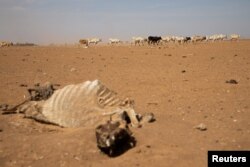
GENEVA —
The World Food Program warns an estimated 20 million people in drought-affected parts of Ethiopia, Kenya and Somalia could face catastrophic levels of hunger if the region is hit with a fourth consecutive year of drought.
The rains have failed to come to the Horn of Africa nearly a month into the current rainy season, which lasts through May. The past three years of drought have taken a heavy toll. The World Food Program reports crop failure in Ethiopia has plunged 7.2 million people into acute hunger and killed more than a million livestock.

The situation is no better in Kenya, where escalating drought has left more than three million people short of food, including half a million who are facing emergency levels of hunger. In Somalia, the WFP says six million people, or 40 percent of the population, are food insecure, with more than 80,000 on the brink of famine.
Speaking from the Kenyan capital, Nairobi, the WFP regional director for East Africa, Michael Dunford, says the number of hungry people could spiral from an estimated 14 million to 20 million, if the rains fail to come yet again.
 A carcass is seen as cattle affected by the drought walk in an open field in Adadle district, Biyolow Kebele in Somali region of Ethiopia, in this undated handout photograph. (World Food Program/Handout via Reuters)
A carcass is seen as cattle affected by the drought walk in an open field in Adadle district, Biyolow Kebele in Somali region of Ethiopia, in this undated handout photograph. (World Food Program/Handout via Reuters)
“The situation is bad. It continues to deteriorate. We are desperate for these rains to succeed,” he said. “But even if they do … these populations are exhausted. The water sources are exhausted. The livestock are dying. The crops are failing. And we are heading to a very severe situation unless we are able to pull it back from the precipice.”
Dunford says there is anecdotal evidence that children already are dying from malnutrition-related causes because they are not able to get the nutritional feeding that could save their lives.
He says the WFP is severely underfunded. It has received 13 percent of a required $370 million. Since that appeal was launched in January, he says the number of people needing help has increased, as have the costs. The WFP now requires $473 million to scale up its operations over the next six months.
“Funding gap means that WFP is having to prioritize in such a way that the prevention of malnutrition, we are now going to have to focus primarily on the treatment,” Dunford said. “And at some point, even these programs will not have sufficient funding if the current trends continue. And we will have to focus exclusively on humanitarian feeding programs.”
Dunford says the fallout from the conflict in Ukraine is compounding the problems in the Horn of Africa, with food and fuel prices soaring to unprecedented highs.



